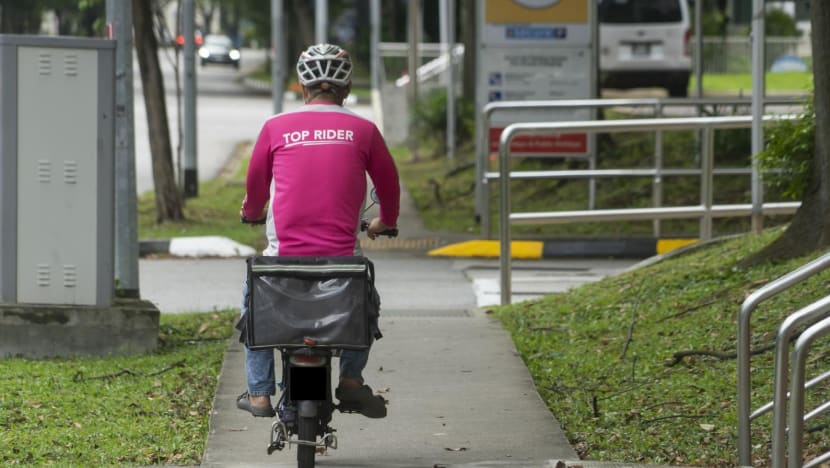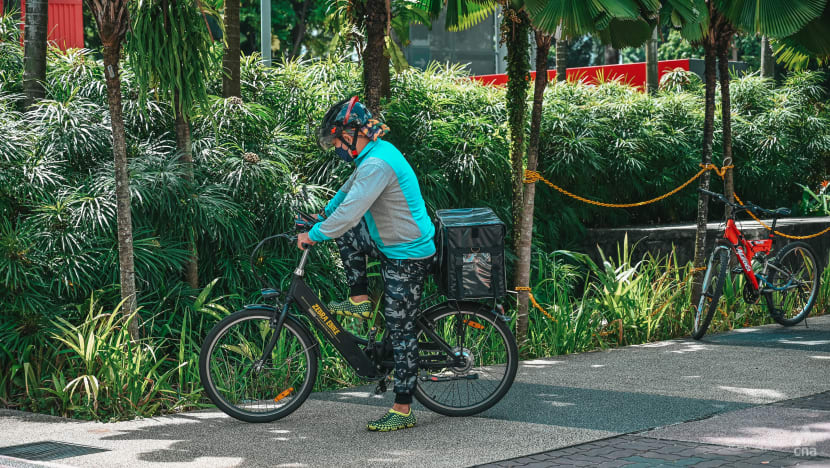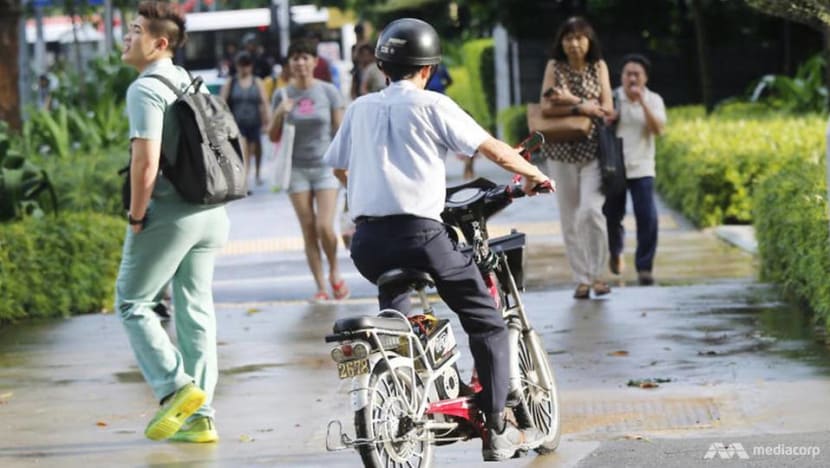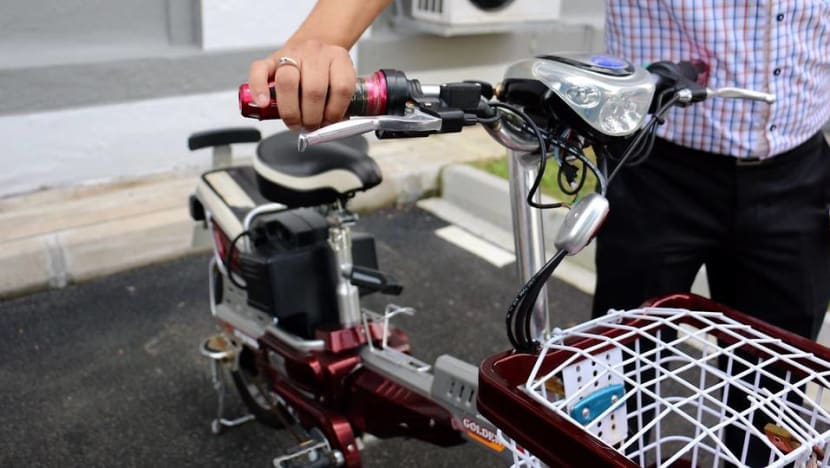E-bike riders tell of poor driver behaviour, restrictive rules as accidents rise
Two weeks ago, an e-bike rider died in a road accident with a car. CNA looks at the dangers that riders face, and how increasingly stringent regulations have affected their safety.

An e-bike rider in Singapore. (File photo: iStock)
SINGAPORE: The number of road accidents involving power-assisted bicycles has steadily risen over the last three years, even after the authorities introduced stricter safety rules for riders such as a mandatory theory test and limits on how fast they can go.
Some riders of power-assisted bicycles – or electric bicycles or e-bikes – told CNA that some vehicles on the road do not respect them and that their own slower speeds have led to near-collisions.
Riders and retailers also called for a review of the weight limit for e-bikes. They acknowledged that this protects other shared path users, but said that heavier e-bikes could mean safer ones in general.
The issue of e-bike safety resurfaced in the public eye on Jun 25, when a car driver was arrested following a deadly accident with a food deliveryman riding an e-bike along Yishun Avenue 9.
The cause of the accident has not been revealed, but Chinese daily Shin Min reported that the front of the car was dented and there were cracks in the windshield.
As tensions between cyclists and motorists continue to simmer, e-bike riders have also ended up on the wrong side of the law. One such rider was charged in court on Jul 3 with punching a cabby last year after smashing into an opened taxi door along Balestier Road.
E-bikes are banned from footpaths, with riders having to stick to roads and shared paths such as cycling paths and park connectors.
They can go up to a maximum speed of 25kmh, and e-bikes must not exceed 20kg in unladen weight.
35 ACCIDENTS IN 2018 TO 157 IN 2022
In 2018, the authorities made it compulsory for all e-bikes to be registered with LTA before they could be used in public.
That year, there were 35 e-bike accidents that led to injuries including one fatality, according to statistics provided to CNA by the Singapore Police Force.
The following year in 2019, the number dropped to 24 with no fatal accidents, before increasing threefold to 78 – including three fatalities – in 2020.
This then doubled to 150 accidents, including three fatal ones, in 2021.
CNA previously reported that the number of e-bikes in Singapore soared between 2020 and 2021 due to increased demand for food delivery services during the COVID-19 pandemic.
More people also turned to e-bikes after the ban on the use of e-scooters and other personal mobility devices (PMDs) on footpaths in November 2019.
In June 2021, the Land Transport Authority (LTA) further mandated that e-bike and e-scooter users would start having to pass an online theory test in order to ride in public. This followed a spate of accidents involving mobility devices.
Nevertheless, the number of e-bike accidents in 2022 rose slightly to 157, including two fatal ones.
Mr Chew Boon Hur, general manager of e-bike retailer Mobot, said demand for e-bikes has remained relatively stable over the last few years, with a majority of riders being in the food delivery sector.
In response to CNA's queries, LTA said that as of end-June, 37,320 power-assisted bicycles have been registered here.
About 3,800 e-bike riders were caught on footpaths from January to June, while 5,380 such riders were nabbed for the same offence in the whole of last year.
LTA also recorded 606 cases of non-compliant e-bikes last year, with another 371 cases from January to June.

"IT TAKES TWO HANDS TO CLAP"
Mr Joshua Chiu, who has ridden e-bikes for more than 10 years and owns a bicycle shop, shared that he often encounters cars breaking the rules by failing to signal when they switch lanes, for instance.
Many cars also do not look out for pedestrians or cyclists like himself when turning at a cross junction on a green man, said the 37-year-old.
He added that while “everything is still all right” if e-bike riders obey the current rules, they are forced to share the roads with cars and heavy vehicles which may not “ensure our safety”.
“It takes two hands to clap because there is no point if we adjust our safety but others don’t. A lot of cars don’t (have) regard (for) our safety also,” he said.
Three other e-bike users who do food delivery echoed Mr Chiu’s concerns.
Mr Kiff Su, 37, said they can only ride on the extreme left lane on double yellow lines, leaving them no space to avoid objects or potholes due to fast-moving vehicles on their right. He has ridden an e-bike for about a year.
“There are many instances where we are blocking buses and cars, so either they (sound their) horn or they try to overtake … and we need to jam our brakes, which is also dangerous,” Mr Su added.
“Actually, quite often there are e-bike accidents, just that not all are reported. Normally, unless it’s very serious or someone dies, then people will know.”
Mr Su said it is “almost impossible” for e-bike riders to switch lanes if they want to make a right turn as well. They often have to park their devices for a while and wait for a chance to do so.

Another rider, who only wanted to be known as Mr Lim, concurred that vehicles like buses and lorries often sounded their horn at him even though he was keeping left and “did no wrong”.
Echoing Mr Chiu’s earlier concerns on cross junctions, Mr Lim said he occasionally runs into trouble at longer cross junctions, such as at the Paya Lebar flyover.
“Sometimes I only manage to cross probably one-quarter of the way, and suddenly the traffic light turns red and I cannot reverse back anymore and my speed is slow.
“If I meet those cars that drive dangerously, I will be in deep trouble with my speed limit.”
Mr Chew from Mobot cautioned that the education process should be an ongoing one and that every road user must be regularly reminded of good riding and driving practices.
He noted that the mandatory theory test that was introduced in 2021 was to raise awareness of good riding practices, active mobility rules among e-bikers.
“At the same, the Singapore police have been educating motorists to keep a lookout for smaller or vulnerable road users such as e-bike riders.
“With these, we are moving in the direction where the safety of road users is dependent on every road user, not just a single category of user," he said.
On its website, LTA advised everyone to "consider the safety of our fellow travellers, no matter whether we drive, walk, cycle or ride active mobility devices".
"LTA’s vision for a car-lite nation is not only about providing the amenities to support walking, cycling and riding, but also building a culture of courtesy and respect for fellow commuters," it added.
SPEED AND WEIGHT LIMITS
Another e-bike rider, Mr Muhammad Rusydi, 21, said that the 25kmh speed limit is too slow and dangerous. They are also unable to change any parts to safer ones due to the 20kg weight limit.
He has done part-time food delivery using a JI-MOVE MC e-bike for nearly two years, having switched from riding a bicycle.
“Some drivers may be in the rush and sometimes there is no cycling path for us,” he pointed out.
Mr Su said the speed limit for e-bikes should be increased to at least 30 to 35kmh, given that even cars on small roads travel around 40kmh.
“Definitely, the current rules are inadequate and not practical. On paper it is easy to simply set rules but on the actual ground, food delivery riders are facing danger on a day-to-day basis,” he told CNA.

Most e-bikes in the market already weigh almost 20kg by default. If the government allows heavier e-bikes, riders like himself can add safety features such as better brakes, horns and signal lights, Mr Su added.
Mr Lim said that stock brakes that come with e-bikes do not have enough braking power at times – especially when “jaywalkers suddenly step out onto the road or some cars just cut in front of me closely”.
“A speed cap at 25kmh in Europe and China is not that bad because they have dedicated lanes for bicycles and e-bikes, but not in Singapore where the roads are narrow,” he pointed out.
Mr Lim called for LTA to revise their rules on e-bikes such as allowing modifications to required electrical parts like front lights and brakes, or increasing the speed limit and weight limit.
However, he said it remains difficult to find reputable repairmen or repair shops for e-bikes.
Mobot’s Mr Chew noted that the 20kg weight limit has been in place to protect other shared path users, such as pedestrians, but agreed that a higher weight limit “will allow for a safer e-bike in general”.
Aside from his wish for the community to work out alternatives or suggestions on this front, he said that enforcement actions on shops that provide illegal modifications must be promptly dealt with.
“Such establishments will create an unsafe product both from a road safety and electrical safety perspective,” he added.


















